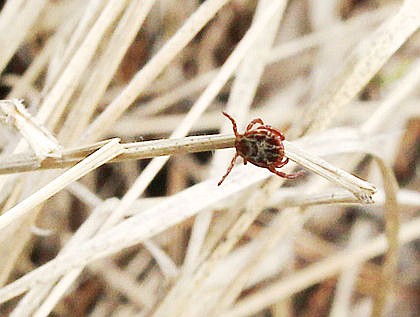Spring can mean discovering ticks in your hair
No longer do I squeal “Get it off me!” when I find a tick crawling on me.
I’ve come to terms with ticks and can flick them off with my fingers — a milestone I never thought would happen. On one spring hike, I picked off two dozen ticks by the time I returned to the trailhead and felt as if more were crawling all over me.
In North Idaho, the Rocky Mountain wood tick is the main tick you’ll find on yourself. Females have a gray colored dorsal shield (area behind their head) and a brown body while males are mottled brown and gray.
A tick progresses through four life stages: egg, six-legged larva, eight-legged nymph and adult. Each life stage requires a blood meal from a host to progress into the next stage. An adult female needs one last blood meal to lay her eggs after which she dies.
In colder climates, this life cycle can take over three years to complete. The Rocky Mountain wood tick takes one week to 38 days to hatch from an egg. The larvae can then survive 117 days without feeding. Nymphs can survive over 300 days without feeding and adults can survive over 600 days without feeding.
These long time spans are crucial if a tick cannot find a host during the summer and has to overwinter in ground debris. Finding a host is like seeing a shooting star — being in the right place at the right time.
Due to the small size of a tick and the mobility of their hosts, ticks play a waiting game called “questing”.
Questing isn’t pure chance. Ticks can sense well-traveled animal trails or resting areas. Similar to mosquitoes, ticks can detect carbon dioxide, body odor, movement and heat emitted from potential hosts. Upon detecting any of these signs, a tick will crawl to the end of a blade of grass or perch on the edge of a leaf on the ground with its front legs extended.
Then it will wait until a host brushes against its front legs so it can climb aboard — which is why we most often find ticks crawling up our pant legs.
Once upon the host, the tick can feed for several days to a week. Ticks don’t immediately latch on to feed, they search for the right spot — one where the skin is thinner like on the ears. A Rocky Mountain wood tick can search for 12 to 24 hours before finding the right spot.
Two mechanisms enable the tick to latch onto its host: mouthparts and glue.
A tick’s mouthparts are barbed like a fish hook and many of us know how hard fish hooks are to remove.
The reason we don’t feel ticks bite is that their saliva has anesthetic properties. The glue is a cement-like substance produced and secreted by the salivary glands that literally glues the feeding tick in place. After feeding is complete the glue dissolves.
Anyone who has had to remove a feeding tick knows how large they can become. Adult Rocky Mountain wood ticks are typically 1/8 to 1/4 inch long and can engorge themselves to half-an-inch long.
Female adult ticks will feed continuously while male adult ticks will feed for a short time before withdrawing their mouthparts and searching for a female before resuming feeding again. Once the female has finished feeding, she will drop off her host and find a suitable spot to lay her eggs. Unfortunately, female Rocky Mountain wood ticks can lay up to 7,400 eggs over the course of a month.
If a tick cannot find a host by the time hot summer temperatures arrive, it will seek cover under leaves and remain dormant until next spring--providing us with a reprieve from ticks during late summer and fall.
For previous columns, visit http://goexploreit.blogspot.com.

